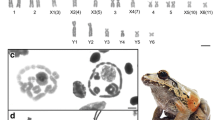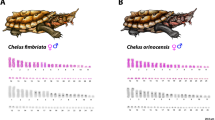Abstract
Sex determination in a group of phylogenetically related Chironomus species, of the pseudothummi complex, from south-eastern Australia and New Zealand is male heterogametic, controlled by a male determiner. The male determiner has been located at least to the level of the chromosome arm in most members of this phylogenetic group. It varies in location among many of the species and there are some phylogenetic patterns discernable, which are discussed in relation to the possible origin of the sex determiner. There is a group of species, Ch. oppositus ff. oppositus and whitei, Ch. australis, Ch. alternans a and Ch. alternans c, which appear to be central to this phylogeny, in which the sex determiner is located near the centromere of the CD chromosome, the most common location in the Australasian group. This is different from the most common location, arm F, of the thummi complex in Europe and North America. There is also a group, comprising Ch. oppositus f. tyleri, Ch. cloacalis, Ch. alternans b and Ch. nepeanensis, in which the sex determiner is on arm G. The arm A sex determiners, found in Ch. tepperi, Ch. oppositus ff. whitei and connori, and Ch. occidentalis, may be of common origin or they may be independently derived, as must be the arm B (Ch. duplex) and arm F (Ch. oppositus f. whitei) sex determiners. In Ch. oppositus f. whitei, four different chromosomal locations for the sex determiner have been identified. It is not yet clear whether these represent an unstable polymorphism or indicate the existence of cryptic subgroupings within this form. Although the location of the sex determiners can be assigned to particular chromosome arms, the precise location cannot be determined, therefore the assumption of common origin may not always be correct. Also, this uncertainty means that it is impossible at present to differentiate between a complex system of sex determination and the possibility of a translocatable sex determiner as explanations of the variability in sex determiner location. The forms of Ch. oppositus are redefined and renamed to avoid confusion caused by the previous names.
Similar content being viewed by others
References
Beermann W (1955) Geschlechtsbestimmung und Evolution der genetischen Y-chromosomen bei Chironomus. Biol Zentralbl 74:525–544
Christidis L (1980) The significance of multiple sex determining regions in Chironomus oppositus Walker (Diptera: Nematocera). Unpubl B Sc (Hons) Rept Univ Melb
Forsyth DJ (1978) Benthic macroinvertebrates in seven New Zealand lakes. NZ J Mar Freshw Res 12:41–49
Green MM (1980) Transposable elements in Drosphila and other Diptera. Ann Rev Genet 14:109–120
den Hollander J (1979) Population genetical studies of the housefly Musca domestica. Ph D Thesis Univ West Aust
Kuvangkadilok C (1984) Genetic variability in populations of Chironomus oppositus. Ph D Thesis Univ Melb & J Aust Ent Soc 23:104 (Abstract)
Lentzios G, Stocker AJ, Martin J (1980) C-banding and chromosome evolution in some related species of Australian Chironominae. Genetica 54:51–68
Martin J (1969) The salivary gland chromosomes of Chironomus oppositus Walker (Diptera: Nematocera) Aust J Zool 17:473–486
Martin J (1971) A review of the genus Chironomus (Diptera, Chironomidae). II. Added descriptions of Chironomus cloacalis Atchley and Martin from Australia. Stud Nat Sci 1(2):1–21
Martin J (1981) Location of a sex determining region in Chironomus tepperi Skuse (Diptera: Chironomidae) using irradiation-induced chromosomal rearrangements. Genetica 57:113–117
Martin J, Lee BTO (1981) Problems in speciation of Chironomus oppositus in south-eastern Australia. In: Atchley WR, Woodruff DS (eds) Essays on evolution and speciation in honor of MJD White. Cambridge UP, London pp 241–261
Martin J, Porter DL (1977) Laboratory biology of the rice midge, Chironomus tepperi Skuse (Diptera: Nematocera): mating behaviour, productivity, and attempts at hybridization. J Aust Entomol Soc 16:411–416
Martin J, Wülker W, Sublette JE (1974) Evolutionary cytology in the genus Chironomus Meigen. Stud Nat Sci 1(12):1–12
Martin J, Lee BTO, Connor E (1978) Apparent incipient speciation in the midge Chironomus oppositus Walker (Diptera: Chironomidae). Aust J Zool 26:323–329
Martin J, Kuvangkadilok C, Peart DH, Lee BTO (1980) Multiple sex determining regions in a group of related Chironomus species (Diptera: Chironomidae). Heredity 44:367–382
Rosin S, Fischer J (1972) Polymorphismus des Realisators für männliches Geschlecht bei Chironomus. Rev Suisse Zool 79 (Suppl):119–141
Rothfels KH (1956) Black flies: siblings, sex, and species grouping. J Hered 47:113–122
Timms BV (1973) A limnological survey of the freshwater coastal lakes of east Gippsland, Victoria. Aust J Mar Freshw Res 24:1–20
White MJD (1978) Modes of speciation. Freeman, San Francisco
Author information
Authors and Affiliations
Additional information
It is a pleasure to dedicate this paper to Professor Hans Bauer, a pioneer of chironomid karyosystematics, on the occasion of his 80th birthday
Rights and permissions
About this article
Cite this article
Martin, J., Lee, B.T.O. A phylogenetic study of sex determiner location in a group of Australasian Chironomus species (Diptera, Chironomidae). Chromosoma 90, 190–197 (1984). https://doi.org/10.1007/BF00292396
Received:
Issue Date:
DOI: https://doi.org/10.1007/BF00292396




